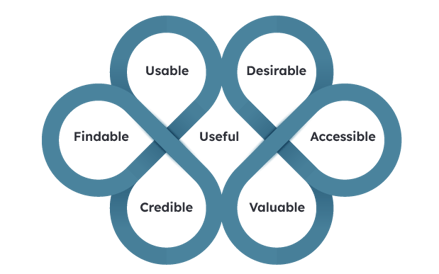While Americans certainly love to shop, work, and check off tasks online, they also expect to move effortlessly between their chosen channels. In fact, users typically interact with a brand through an average of six touchpoints before making a purchase. Due to this channel-shifting behavior, it's imperative for businesses to not only recognize the significance of user experience (UX) but also develop a winning strategy that ensures seamless interaction and engagement across digital platforms.
Keep reading to uncover the critical components of crafting a digital UX strategy, integrating insights from industry experts and essential statistics that highlight the importance of prioritizing UX in 2024 and beyond.
Understanding Digital UX
UX captures the overall experience a user has while interacting with a website, application, or digital service. As consumer behavior continues to evolve, so do UX practices. Today, users expect effortless navigation across digital and non-digital channels, with 71 percent preferring different channels based on their specific needs. Additionally, a staggering 74 percent of consumers expect digital platforms to offer the same capabilities as their non-digital counterparts.
In response to these shifting demands, businesses must adopt a strategic approach to UX design—one that goes beyond surface-level aesthetics to address underlying user needs and preferences.
Creating a Digital UX Strategy
Setting Clear Objectives and Goals
To set themselves up for digital UX success, businesses must articulate specific outcomes they aim to achieve through their user experience efforts. These objectives should be closely aligned with overarching business strategies, ensuring that every aspect of the UX design contributes to the organization's success.
Consider an e-commerce company looking to enhance its online shopping experience. One of its primary business goals might be to increase conversion rates and drive higher sales revenue. To achieve this, its UX objectives could focus on streamlining the checkout process, reducing cart abandonment, and improving overall customer satisfaction.
However, setting objectives is only the first step. To measure progress and effectiveness, organizations need to identify key performance indicators (KPIs) that provide quantifiable metrics for evaluating the user experience. KPIs serve as benchmarks against which the success of the UX strategy can be assessed, offering actionable insights into areas of strength and opportunities for improvement.
Conducting User Research and Analysis
Before finessing your UX strategy, it's essential to have a deep understanding of the current state of user experiences and journeys. This involves mapping out the various touchpoints and interactions users have with a product or service—whether it's navigating a website, using a mobile app, or engaging with a digital platform.
By gaining insight into how users currently interact with the product or service, businesses can identify pain points, inefficiencies, and areas for improvement
Utilizing various research methods (including surveys, interviews, and analytics) businesses can gather diverse perspectives and data points that inform their UX strategy. Surveys provide quantitative data by collecting responses from a large sample of users, while interviews offer qualitative insights by delving deeper into individual user experiences and motivations.
Additionally, analytics tools provide valuable data about user interactions with digital platforms, enabling businesses to track metrics and identify user behavior patterns.
Creating User Personas and Journey Mapping
User personas and journey mapping serve as essential tools for businesses to deeply understand and empathize with their target audience. These methodologies allow organizations to humanize their users, going beyond mere demographic data to uncover the motivations, goals, and pain points that shape their interactions with products or services.
By crafting detailed user personas that represent different segments of their audience, businesses can gain insights into their users' diverse needs and preferences. Lastly, aligning these persona insights with journey mapping enables organizations to visualize the entire user experience from start to finish.
Journey mapping involves mapping out the various touchpoints and interactions that users have with a product or service, charting their paths from initial awareness to eventual conversion or goal completion. This holistic view of the user journey enables businesses to identify critical moments of engagement as well as potential areas of friction or frustration.
Designing for Seamless Interaction and Engagement
In designing for seamless interaction and engagement, businesses must prioritize intuitive navigation and user-friendly interfaces. Responsive design ensures that users can access and interact with the product or service seamlessly across different devices and screen sizes.
Additionally, incorporating interactive elements such as animations, gestures, and micro-interactions can enhance user engagement and delight.
Drawing insights from the UX framework (which emphasizes components such as usability, findability, and desirability) can further guide the design process.
- Useful: Focuses on ensuring the product meets genuine user needs through thorough research.
- Usable: Prioritizes intuitive interfaces and navigation to minimize user frustration.
- Desirable: Aims to captivate users emotionally through appealing design elements.
- Findable: Ensures users can quickly locate content and features within the product.
- Accessible: Emphasizes inclusivity by ensuring all users, regardless of abilities, can interact effectively.
- Credible: Builds trust and reliability through transparent processes and clear communication.
- Valuable: Aims to deliver tangible benefits and fulfill user expectations, ultimately creating lasting value.

Iterative Prototyping and Testing
Iterative prototyping and testing allow organizations to validate design concepts and functionality, gathering feedback from target users along the way. Usability testing helps identify areas for improvement, enabling iterative refinement based on real-world insights.
By embracing a cycle of continuous iteration, businesses can ensure that their UX strategy remains responsive to evolving user needs.
Collaboration and Communication Across Teams
Effective collaboration and communication are essential for creating cross-functional alignment and ensuring consistency in UX strategy. By bringing together design, development, and business teams, organizations can leverage diverse perspectives to drive innovation and iteration.
Open communication channels facilitate feedback and iteration, promoting a culture of continuous improvement.
Implementing Metrics and Continuous Improvement
Metrics play a crucial role in evaluating the performance and effectiveness of a UX strategy. By tracking UX metrics and analyzing data, businesses can identify areas for improvement and implement iterative enhancements.
Continuous improvement is vital to staying ahead in digital UX, where user expectations and technologies are constantly evolving.
Embracing Emerging Technologies and Trends
Integrating advancements such as artificial intelligence (AI), voice user interfaces, and augmented/virtual reality into UX strategies enables organizations to anticipate and adapt to changing user expectations.
By embracing innovation, businesses can future-proof their UX strategy and deliver cutting-edge experiences to their customers.
Create a "Crazy-Easy" Digital Experience
Today’s customers demand nothing less than a seamless digital experience. At Andrew Reise, we analyze your digital interactions, products, services, and interfaces to formulate a comprehensive strategy aimed at optimizing the entire digital journey.
Visit our Digital Experiences Solutions page to learn how we can help you optimize your brand’s online experiences.


